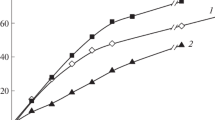Abstract
The shrinkage of polyacrylonitrile fibres comprising 93% acrylonitrile, 5.7% methyl acrylate, and 1.3% itaconic acid was investigated by a thermomechanical method in heating them from room temperature to 300°C. It was shown that the irreversible shrinkage of the fibres during their first heating is due to a decrease in the stresses accumulated during spinning. The shrinkage observed in repeated heating of the fibres is caused by two processes: 1) by unfolding of segments of PAN macromolecules in the amorphous constituent of the structure of the polymer with an increase in the temperature (thermoelastic effect); this part of the shrinkage is reversible in heating-cooling cycles; 2) by cyclization of the polymer units due to polymerization of CN groups; this is the irreversible part of the shrinkage. In the 200–300°C temperature region, relaxation processes caused by irreversible unfolding of the macromolecules of the “melted” ordered structure of the fibre also contribute to the shrinkage. Mechanisms of the shrinkage processes in a wide range of temperatures are proposed. Shrinkage caused by physical processes of transformation of the structure of the fibre and chemical processes of formation of heterocycles is distingguished. It was shown that the kinetics of cyclization of PAN fibres can be investigated during their thermooxidative stabilization as one of the stages of fabrication of carbon fibres from PAN based on thermomechanical data.
Similar content being viewed by others
References
R. C. Houtz,Text. Res. J.,20, 786 (1950).
N. Grassie, J. N. Hay, and J. C. McNeil,J. Polym. Sci.,31, 205 (1958).
W. J. Burlant and J. L. Parsons,J. Polym. Sci.,22, 249 (1956).
J. Hoh and H. Yu,J. Polym. Sci.,B 4, 721 (1966).
I. A. Drabkin, et al.,Dokl. Akad. Nauk SSSR,154, 197 (1964).
E. Fitzer, W. Frohs, and M. Heine,Carbon,24, 387 (1986).
Grove Dale, P. Desai, and A. S. Abhiraman,Carbon,26, 404 (1988).
G. S. Bhat, F. L. Cook, et al.,Carbon,28, 377 (1990).
Z. Bashir,Carbon,29, 1081 (1991).
O. V. Zhidkova, I. N. Andreeva, et al.,Khim. Volokna, No. 5, 25 (1993).
H. Kakida, K. Tashiro, and M. Kobayashi,Polym. J.,28, 30 (1996).
H. Kakida and K. Tashiro,Polym. J.,30, 463 (1998).
E. Fitzer and D. J. Muller,Macromol. Chem.,144, 117 (1971).
O. P. Bhal and R. B. Mathur,Fiber Sci. Techn.,12, 31 (1976).
P. H. Wang,J. Appl. Polym. Sci.,67, 1185 (1998).
R. B. Mathur, O. P. Bhal, et al.,Carbon,26, 295 (1988).
A. Manahan,Polym. Sci. A.,14, 239 (1966).
H. Kakida and K. Tashiro,Polym. J.,30, 74 (1998).
Additional information
All-Russian Scientific-Research Institute of Polymer Fibres, Mytishchi. Translated fromKhimicheskie Volokna, No. 5, pp. 46–53, September–October, 2000.
Rights and permissions
About this article
Cite this article
Kalashnik, A.T., Serkov, A.T. Mechanisms of transformation of acrylic fibres during thermooxidative stabilization. Fibre Chem 32, 356–364 (2000). https://doi.org/10.1007/BF02360643
Issue Date:
DOI: https://doi.org/10.1007/BF02360643




